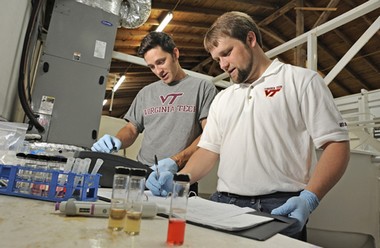Virginia Tech researchers create competitive, global aquaculture market
Published: July 9, 2012
By: Virginia Tech University
When Chesapeake Bay oyster hatcheries began to see the unexplainable deaths of billions of larvae during summer 2011, the competing companies banded together to find someone to fix the problem.
That person was David Kuhn, assistant professor with Virginia Tech’s Department of Food Science and Technology in the College of Agriculture and Life Sciences.

Hatchery manager Mike Congrove, at left, shows David Kuhn, assistant professor in the College of Agriculture and Life Sciences, young oysters growing at Oyster Seed Holdings in Grimstead, Va. Millions of oysters are grown in hatcheries in Virginia and later put into the Chesapeake Bay.
Kuhn and other university researchers are conducting a first-ever test of water quality in Virginia’s oyster aquaculture hatcheries. The hatcheries provide millions of young oysters for the bay and pour millions of dollars into the state’s economy.
The research could expand the aquaculture industry, as well as assist with the complex restoration efforts of the Chesapeake Bay. Hatcheries sell the oysters to private farms and to state agencies, which use the oysters to help restore the bay.
Kuhn’s work is one of the aquaculture projects Virginia Tech researchers are involved in around the commonwealth. Aquaculture provides a source of protein to an ever-hungry world and drives economic growth. Other environmentally sustainable programs involve growing shrimp and tilapia and finding ways to maximize the quality of the fish.
“Our efforts in aquaculture around the state are helping make Virginia a competitor in the growing global market,” Kuhn said. “The research at oyster hatcheries is an opportunity for Virginia Tech to help both the state’s industry and the environment.”
The one-year, joint-research project received funding from the Virginia Marine Resources Commission. The Virginia secretary of natural resources and the Virginia Coastal Zone Management Program secured the money.
Researchers are testing water pumped from the bay to the hatcheries for pollutants. The plan is to identify the problem that led to the die-offs, then install a filter or treat the water. Hatchery employees conduct continuous, on-site monitoring.
“There has never been a water-quality program where the hatcheries are located,” Kuhn said. “This is important data for anyone concerned about the bay.”

Daniel Taylor, at left, senior research specialist, and David Kuhn, assistant professor, both in the Department of Food Science and Technology, test water from oyster hatcheries for a host of pollutants and chemicals that may have been responsible for the crash of millions of young oysters in 2011.
Daniel Taylor, a senior research specialist with the Southwest Virginia Aquaculture Research Center, said a number of factors are causing the damage to the oyster hatcheries. “In the end, we could present some kind of a solution where one mitigation effort will assist with another one, and we could come up with a program that addresses one or two issues simultaneously,” he said.
The aquaculture industry not only pumps money into the state, but also sucks pollution from the bay. Adult oysters can filter as much as 60 gallons of water a day, pulling out pollutants in the process.
“By providing a healthy bay, you are not only boosting the economy, but you are also improving the ecological health of the watershed,” Taylor said. “That alone has tremendous ecological value.”
Researchers also are working on ways to create a self-sustaining, miniature ecosystem in aquaculture farms.
Fish and shrimp create waste, including nitrate. Studies show that high levels of nitrate compromise shrimp health and growth. Kuhn looked at using a biological filter to remove the nitrate present in tilapia wastewater while generating healthy bacteria.
“We can use that good bacteria to feed the shrimp,” he said. The goal is to find ways to reduce those levels by using biological filtration or simply replacing the old water, he said.
Scientists also are focused on practices for handling, processing, and storing freshwater shrimp. They want to maintain the quality and food safety of the large shrimp. The quality includes the taste, odor, texture, and appearance of the shrimp. The researchers want to see how much bacteria is in the shrimp’s food.
Virginia Tech is working with employees from Blue Ridge Aquaculture in Martinsville, Va., where Kuhn is developing new strategies to raise marine shrimp in recirculating water systems to provide domestically produced shrimp.
Kuhn and Taylor also are helping Virginia Cobia Farms in Saltville, Va., to streamline production of two marine fish, cobia and pompano, in recirculating aquaculture systems.
Other programs include an effort to add algae to tilapia feed to increase the omega-3 fatty acids, which would increase the fish’s market value.
“From the corners of Southwest Virginia to the Chesapeake Bay, Virginia Tech is involved in a variety of projects to help aquaculture drive the economy and help save the environment,” said Joe Marcy, head of the Department of Food Science and Technology.
Source
Virginia Tech UniversityRelated topics:
Recommend
Comment
Share

Would you like to discuss another topic? Create a new post to engage with experts in the community.



